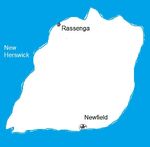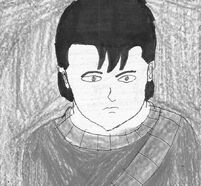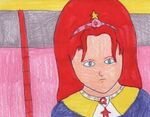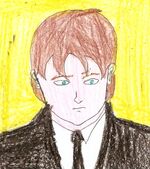No edit summary Tag: sourceedit |
Tag: Visual edit |
||
| (3 intermediate revisions by one other user not shown) | |||
| Line 29: | Line 29: | ||
===Founding and rule of Curtis I=== |
===Founding and rule of Curtis I=== |
||
| − | The island now known as New Herswick was inhabited by a group of people called the Gaarps before English-speaking settlers arrived in the late 1700s. In the 1790s, English-speaking people arrived to the island, many of them from Herswick. In 1795, the island was named New Herswick, in honor of the birth nation of many of the new settlers. In 1796, the new settlers chose a location for their new nation's capital city, and a Government House was built on a hill now known as [[Berlock Hill (New Herswick)|Berlock Hill]]. In 1797, the new settlers began deciding on what form of government they wanted for New Herswick. They decided that they wanted a monarchy, as that was the form of government Herswick had. On 5 December 1797, a man named Curtis Gayoule became [[Curtis I of New Herswick|King Curtis I]] when he was chosen by the people to be |
+ | The island now known as New Herswick was inhabited by a group of people called the Gaarps before English-speaking settlers arrived in the late 1700s. In the 1790s, English-speaking people arrived to the island, many of them from Herswick. In 1795, the island was named New Herswick, in honor of the birth nation of many of the new settlers. In 1796, the new settlers chose a location for their new nation's capital city, and a Government House was built on a hill now known as [[Berlock Hill (New Herswick)|Berlock Hill]]. In 1797, the new settlers began deciding on what form of government they wanted for New Herswick. They decided that they wanted a monarchy, as that was the form of government Herswick had. On 5 December 1797, a man named Curtis Gayoule became [[Curtis I of New Herswick|King Curtis I]] when he was chosen by the people to be their monarch. Under Curtis I's rule, New Herswick enjoyed years of prosperity, and the [[Palace of New Herswick]] was built. Curtis I ruled the nation with the people's interests at heart. His reign lasted from 1797 to 1814. |
===Rule of Curtis II=== |
===Rule of Curtis II=== |
||
| − | After Curtis I died on 27 June 1814, his son [[Curtis II of New Herswick|Curtis II]] became king. During his reign, New Herswick entered an era of turmoil that lasted for almost twenty years. Curtis II made plans to conquer other islands and make colonies out of them, and he succeeded at his plan, colonizing twelve islands and sending police there to beat and kill the colonies' residents. In New Herswick, the people suffered as they were not allowed to do anything without Curtis II's approval. It is said that Curtis II ruled New Herswick more like a dictatorship than like the monarchy his father ruled. Curtis II even secretly made deals with [[Maorda]] (now the [[Maordan Union]]), which was a dictatorship and continues to be to this day. In 1818, a plague occurred in the New Herswick countryside. People suffered, and, by the end of the plague in 1822, more than 4,000 people had died. Curtis II continued his brutality, and by 1828, the people of New Herswick had had enough of Curtis II's brutality, and decided to revolt. Upon hearing of the people's revolt on |
+ | After Curtis I died on 27 June 1814, his son [[Curtis II of New Herswick|Curtis II]] became king. During his reign, New Herswick entered an era of turmoil that lasted for almost twenty years. Curtis II made plans to conquer other islands and make colonies out of them, and he succeeded at his plan, colonizing twelve islands and sending police there to beat and kill the colonies' residents. In New Herswick, the people suffered as they were not allowed to do anything without Curtis II's approval. It is said that Curtis II ruled New Herswick more like a dictatorship than like the monarchy his father ruled. Curtis II even secretly made deals with [[Maorda]] (now the [[Maordan Union]]), which was a dictatorship and continues to be to this day. In 1818, a plague occurred in the New Herswick countryside. People suffered, and, by the end of the plague in 1822, more than 4,000 people had died. Curtis II continued his brutality, and by 1828, the people of New Herswick had had enough of Curtis II's brutality, and decided to revolt. Upon hearing of the people's revolt on 3 August 1828, Curtis II ordered his law enforcement to hang and behead the rebels. By 1833, about fifty people were hanged, and 100 were beheaded. |
====15 November 1833==== |
====15 November 1833==== |
||
| Line 59: | Line 59: | ||
==Climate== |
==Climate== |
||
| − | New Herswick enjoys year-round mild climate. Temperatures never drop below 15.56°C (60°F), and may rise up to 35°C (95°F). In January, temperatures average from 16.11°C (61°F) to 26.11°C (79°F). In July, temperatures average from 22.22°C (72°F) to 33.33°C (92°F). The wet season in New Herswick is usually from June to October. New Herswick usually receives an average of up to |
+ | New Herswick enjoys year-round mild climate. Temperatures never drop below 15.56°C (60°F), and may rise up to 35°C (95°F). In January, temperatures average from 16.11°C (61°F) to 26.11°C (79°F). In July, temperatures average from 22.22°C (72°F) to 33.33°C (92°F). The wet season in New Herswick is usually from June to October. New Herswick usually receives an average of up to 1,067 millimetres (42 inches) of rain a year. |
==Economy== |
==Economy== |
||
| Line 96: | Line 96: | ||
The Prime Minister is appointed by the monarch after an election. He or she is asked to select people to head the government departments. The Prime Minister also selects people to make up his or her Cabinet. |
The Prime Minister is appointed by the monarch after an election. He or she is asked to select people to head the government departments. The Prime Minister also selects people to make up his or her Cabinet. |
||
| − | New Herswick has two chief political parties. These political parties are the [[Tairon Party]] and the [[Zakou Party]]. The Tairon Party supports |
+ | New Herswick has two chief political parties. These political parties are the [[Tairon Party]] and the [[Zakou Party]]. The Tairon Party supports government action in economic affairs and social affairs. The Zakou Party favours less government interference. |
==Military== |
==Military== |
||
Latest revision as of 20:06, 16 June 2018
|
New Herswick
| |
|
Official name
|
Constitutional Monarchy of New Herswick
|
|
Capital
|
|
|
Large cities
|
Newfield
Rassenga |
|
Founded
|
1794
|
|
Demonym(s)
|
New Herswegian
|
|
Official language(s)
|
English
Gaarpish |
|
Form of Government
|
Constitutional monarchy
|
|
Monarch
|
|
|
Prime Minister
|
|

A map of New Herswick.
New Herswick, officially named the Constitutional Monarchy of New Herswick, is an island nation located in the Marrianik Sea. New Herswick is named after the former nation of Herswick, which was named after Captain William S. Herswick, who was the first English-speaking person to explore the former nation of Herswick in 1604. New Herswick's capital city and largest city is Newfield. New Herswick is a constitutional monarchy, and its current monarch is Queen Claire III, who took the throne in 2007, succeeding King Howard II. The nation's current Prime Minister, Dylan Charano, became the Prime Minister in 2008, upon the death of former Prime Minister Stuart Fahlay.
History[]
Founding and rule of Curtis I[]
The island now known as New Herswick was inhabited by a group of people called the Gaarps before English-speaking settlers arrived in the late 1700s. In the 1790s, English-speaking people arrived to the island, many of them from Herswick. In 1795, the island was named New Herswick, in honor of the birth nation of many of the new settlers. In 1796, the new settlers chose a location for their new nation's capital city, and a Government House was built on a hill now known as Berlock Hill. In 1797, the new settlers began deciding on what form of government they wanted for New Herswick. They decided that they wanted a monarchy, as that was the form of government Herswick had. On 5 December 1797, a man named Curtis Gayoule became King Curtis I when he was chosen by the people to be their monarch. Under Curtis I's rule, New Herswick enjoyed years of prosperity, and the Palace of New Herswick was built. Curtis I ruled the nation with the people's interests at heart. His reign lasted from 1797 to 1814.
Rule of Curtis II[]
After Curtis I died on 27 June 1814, his son Curtis II became king. During his reign, New Herswick entered an era of turmoil that lasted for almost twenty years. Curtis II made plans to conquer other islands and make colonies out of them, and he succeeded at his plan, colonizing twelve islands and sending police there to beat and kill the colonies' residents. In New Herswick, the people suffered as they were not allowed to do anything without Curtis II's approval. It is said that Curtis II ruled New Herswick more like a dictatorship than like the monarchy his father ruled. Curtis II even secretly made deals with Maorda (now the Maordan Union), which was a dictatorship and continues to be to this day. In 1818, a plague occurred in the New Herswick countryside. People suffered, and, by the end of the plague in 1822, more than 4,000 people had died. Curtis II continued his brutality, and by 1828, the people of New Herswick had had enough of Curtis II's brutality, and decided to revolt. Upon hearing of the people's revolt on 3 August 1828, Curtis II ordered his law enforcement to hang and behead the rebels. By 1833, about fifty people were hanged, and 100 were beheaded.
15 November 1833[]
Main article: New Herswick Battle of November 1833
In November 1833, Curtis II's son and heir to the throne of New Herswick, Curtis Gayoule III, led a group of rebels to Newfield, where they planned to find Curtis II and force him to leave the throne. Curtis II received word of what was coming, and he rallied his law enforcement. When Curtis III and the rebels reached Newfield, they found Curtis II's law enforcement waiting for them. The New Herswick Battle of November 1833 began on 15 November 1833. Curtis III and his forces defeated Curtis II's law enforcement and continued toward the Palace of New Herswick, where Curtis II was hiding, hoping his son would not find him. By nightfall on 15 November 1833, Prince Curtis III and his forces stormed the palace, and Curtis II was surrounded, with nobody to help him. An hour later, Curtis III entered the room where his father was hiding. Curtis III then ordered his father to leave the throne on his own accord, or he will be forced to leave. Curtis II refused to step down, and was reminded that he was alone, thus outnumbered "the entire nation to one". A practically defeated Curtis II then told his son that he surrendered, and was allowed to leave. Curtis III was considered to have won the battle, and was crowned King Curtis III of New Herswick on 16 November 1833. Curtis II was sentenced to "exile" on one of the most inhospitable islands in the world, but he refused to go, and climbed to the top of the Palace of New Herswick and jumped off, killing himself.
After Curtis II's reign[]

Curtis III after defeating his father in war.
After defeating his father and taking the throne, Curtis III granted New Herswick's colonies freedom, believing that his father had colonized them out of greed. He also began undoing the damage that his father had done. Curtis III's goal was to be more like Curtis I, keeping the nation's people's interests at heart and not abusing his powers. Curtis III ruled New Herswick for half a century, living to be 83 years old. During Curtis III's fifty-year reign, New Herswick prospered into a great tourist attraction.
After Curtis III died in 1883, the people of New Herswick held what they called "a great funeral for such a great monarch." Curtis III was buried at what is now Newfield Royal Cemetery. Curtis III's son, Stephen, became King Stephen I. Stephen I ruled the nation when an unnamed hurricane hit the island in 1893. The hurricane did not cause much damage in Newfield, but it did cause much damage to coastal towns on the east coast of the nation. Stephen I sent whatever help he could to victims of the storm, but the nation still needed more help. Stephen I turned to Dragoonasag for help. Dragoonasag sent help to New Herswick, and, by 1895, much of the affected parts of New Herswick had recovered. By the end of the Nineteenth Century, the nation was being envied by Maorda, whom Curtis II had made befriended and had made secret deals. In 1901, Maordan troops began invading New Herswick. Stephen I responded to the invasion by rallying whatever troops he had and going to war with Maorda. Thus, the New Herswick War of 1901-1904 began. Going into the war, New Herswick's troops were outnumbered by Maordan troops, 11,234 to 500,000. Stephen I once again turned to other nations for help. In July 1901, Dragoonasag, still angry at Maorda for betraying them in a past war and having found out Maorda was power hungry and had evil intentions, sent troops to New Herswick to help fight the Maordan intruders. The Maordan army, called the "Buhattoxz", advanced toward Newfield, where Dragoonish and New Herswick troops were waiting for them. The sides engaged in a two-day battle just outside of Newfield that resulted in five New Herswick soldiers and 200 Maordan soldiers dead. The sides continued to engage in battle for three years. In 1904, the Maordan troops surrendered after losing many men. After the war, the people of New Herswick struggled to return to the way their lives were before the war.
In 1910, Douglas DuBaer became the country's first Prime Minister after the nation became a constitutional monarchy in 1909. While DuBaer was Prime Minister, the nation experienced economic growth. Cities sprang up; roads began criss-crossing the nation, and new businesses began operating. By the time DuBaer left the position of Prime Minister in 1923, fifteen new businesses had begun operating. In 1926, Newfield's Deroullan Street had become a thriving business centre. In 1927, Prime Minister Mark Feouil presented a plan to set aside land for a national park, now called Feouil National Park, located fifty miles north of Newfield. In 1928, the government of New Herswick created five states, which lasted from 1928 to 1946. In 1946, New Herswick's states were done away with.
In the 1950s, New Herswick became a major tourist centre, attracting tourists from around the world to its sunny beaches. The country's cities were modernized, and roads were improved. In the 1960s, the New Herswick National Highway System was created. The next decade, the nation's transportation department created a system of freeways to connect the nation's large cities.
In the 1980s, the government of New Herswick set aside land for the Matt Greina Military Base, which was named after Matt Greina, the prime minister of New Herswick for the first half of the 1980s. In 1986, Hurricane Chalito dumped heavy rains and caused damage to the nation's north coast. Chalito left low-lying areas in northern New Herswick under water.
In the 1990s, a section of Newfield's Garfel Street called the "Mile of Dreams" became known as one of Newfield's busiest shopping areas.
In the 2000s, New Herswick adopted its current flag.
Climate[]
New Herswick enjoys year-round mild climate. Temperatures never drop below 15.56°C (60°F), and may rise up to 35°C (95°F). In January, temperatures average from 16.11°C (61°F) to 26.11°C (79°F). In July, temperatures average from 22.22°C (72°F) to 33.33°C (92°F). The wet season in New Herswick is usually from June to October. New Herswick usually receives an average of up to 1,067 millimetres (42 inches) of rain a year.
Economy[]
Since the 1990s, New Herswick's economy has been great. The nation's economy depends on agruiculture, foreign trade, and manufacturing, and tourism. New Herswick trades with other English-speaking nations such as Reynoldsland and Dragoonasag, as well as the nation of Borragheou.
New Herswick has minerals such as gold, natural gas, and iron ore, all of which are important to the country. The country's main exports include sugar cane, coconuts, and a native fruit called panoukha.
The country's large cities, Newfield and Rassenga, rank as the country's leading manufacturing centres.
Currency[]
The basic monetary unit of New Herswick is the New Herswick dollar, which became the basic unit in 1976. One New Herswick dollar is worth five real-world U.S. dollars and two Dragoonish dollars. Paper money comes in 1, 5, 10, 15, 20, 25, 30, 50, 100, and 200 bills.
Before 1976, the nation's basic monetary unit was the pahira, worth half a New Herswick dollar.
Culture, customs, and the arts[]
The people of New Herswick love being outdoors. They enjoy such hobbies such as soccer, swimming, and surfing. About 70 percent of the nation's people live near the coast, and many citizens like to spend much of their free time at the beaches. People in the New Herswick Interior enjoy hunting and fishing at lakes. The English-speaking settlers carry on customs brought to the nation by their ancestors, as well as customs the settlers came up with themselves. The Gaarp population still carry on customs of their ancestors.
New Herswick has about forty theatres; the most famous of these are Newfield's Fenuilo Theatre, Rassenga's Blarina Theatre, and Thurston's Bluehammer Theatre.
New Herswick's people drive on the right side of the road; they drove on the left side until 1989.
Holidays[]
New Herswick has eight national holidays, which include Founding Day on 12 May, the Monarch's Birthday, which is currently celebrated on Queen Claire III's birthday, 21 May, and New Herswick Soldiers' Day on 14 August.
Government[]

Claire III, current queen of New Herswick

Current prime minister Dylan Charano
New Herswick is a constitutional monarchy. Queen Claire III is the nation's current monarch and head of state. The monarch reigns, but does not rule the country. The Prime Minister, currently Dylan Charano, is the head of government. New Herswick's lawmaking body is the Parliament of New Herswick. New Herswick currently has no states or provinces, and therefore, has no state or provincial government.
The monarchy of New Herswick has existed since the late 1700s. The throne of New Herswick is passed from a monarch to his or her oldest son. If a monarch has no son, then the throne is passed to the monarch's oldest daughter.
The Prime Minister is appointed by the monarch after an election. He or she is asked to select people to head the government departments. The Prime Minister also selects people to make up his or her Cabinet.
New Herswick has two chief political parties. These political parties are the Tairon Party and the Zakou Party. The Tairon Party supports government action in economic affairs and social affairs. The Zakou Party favours less government interference.
Military[]
New Herswick's military consists of the Army, Navy, and the Air Force. The nation's military is called the Vijaou by native Gaarps. Military service in New Herswick is voluntary.
Transportation[]
New Herswick is served by a network of freeways, called New Herswick Freeways (NHFs). These freeways link the nation's largest cities. The nation is also served by a network of New Herswick National highways (NHNHs). As there are no states or provinces in New Herswick, the nation has no state or provincial highway systems.
The nation is also served by a network of railroads. The New Herswick Royal Railroad is the nation's largest railroad company.
The nation has three major airports, two of which are in Newfield. The Newfield Airport and King Howard II Airport are located in Newfield. The Rassenga International Airport is in Rassenga, as the name suggests.
